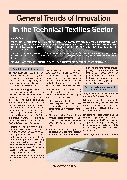General Trends of Innovation in thethe TechnicalTechnical TextilesTextiles SectorSectorin Introduction Introduction The first-generation textile fibres were those that were procured directly from the nature and that era lasted The first-generationtextilewerethosethat wereprocured adirectlythe natureand thatera calledlasted man-for 4,000 for 4,000 years.Manyfibres yearsbefore,sciencedevelopedsecondfrom generationof newfibres, years. madeMany fibres.years Nylonbefore, andsciencedevelopedasecondgenerationofnewfibres,calledman-madefibres.Nylon polyester are two examples of them, a result of the efforts taken by chemists in and polyesteraretwoexamplesofthem, thata resultof the naturalefforts fibres.taken by chemists in 1950, to evolve with materials that 1950, to evolve with materialsresemble resemble natural fibres. Currently the research focuses mainly on finding materials that meet technical needs in various sectors. Currentlyresearchfocuses mainlyon findingthat meettechnicalneeds in varioussectors. This This the involvesthe developmentof veryspecificmaterials fibres, fabricsand finishingprocesses,using technologyto in- customervolvesthedevelopmentofveryspecificfibres,fabricsandfinishingprocesses,usingtechnologytomeet meet customer demands. demands. Keywords:Innovation,functionalization,plasma,electrospinning,nanotechnology,finishingprocesses.Keywords:Innovation,functionalization,plasma,electrospinning,nanotechnology,finishingprocesses. Trends in technical textiles The global technical textile market (in- cluding 3D knitting and weaving, nan- otechnology…) size was estimated at USD 176.6 bn in 2019 globally, grow- ing at a compound annual growth rate (CAGR) of 4.5% from 2020 to 2027. New and improved applications of tech- nical textiles can project to propel its demand across various end-use indus- tries including agriculture, construction, aerospace, medical or packaging, where these textiles can fit better than other solutions and they may facilitate some functions and increase the per- formance of the processes. Neverthe- less, it is important to mention that oth- er sectors like security forces, firefight- ers or foundry workers, for example, depend on technical textiles, so its demand it’s unlikely to decrease. From the perspective of innovation, the continued development of new fibres or improved fibres, the new combina- tions or processing of existing materi- als, the continuous creation of new styles and designs or the increasing application of textile materials in indus- trial uses and in the services, have been the main engines of the textile industry in the last decades. Those have proven to be the cornerstone of European companies for improving their competitiveness in the global market.Technology used in technical textiles’ production is mostly alike to the regu- lar textile manufacturing processes in terms of equipment (except for certain products). The main difference remains in the level of requirements and the quality of the final product demanded. The common trends of innovation in technical textiles can be stated as ( Textile Strategy for Innovative Higher Education. Rimvydas Milašius et al.):high cost and performance and, es- pecially, by the application of the technological innovations of the general textile sector to articles of technical use (microfibres, new breathable finishes, grafting tech- niques of monomers, etc.) Main research lines in materials, structures and treatments Stages of the life cycle of materials and manufacturing systems •The dynamism, at the level of prod- uct development, to respond to new market-pull demand or to replace other materials in analogous func- tions.Different technologies used today in the textile industry can be arranged in a stages of maturity chart, depending on their technological growth and their development level. •The multiplicity of possibilities for the selection of materials, struc- tures, products manufacturing and their adaptation to very diverse uses. •A slow but continuous progress of substitution of conventional raw materials for new materials ofHigh tech fibers are already maturing (aramids, polyetherketones, PBI, etc.) while others (e.g. PBO) are growing, along with the ecological fibers, due to the increasing collective sensitivity towards energy conservation and ecol- ogy aspects. NCM-OCTOBER 2021 45Technologies such as the manufac-
